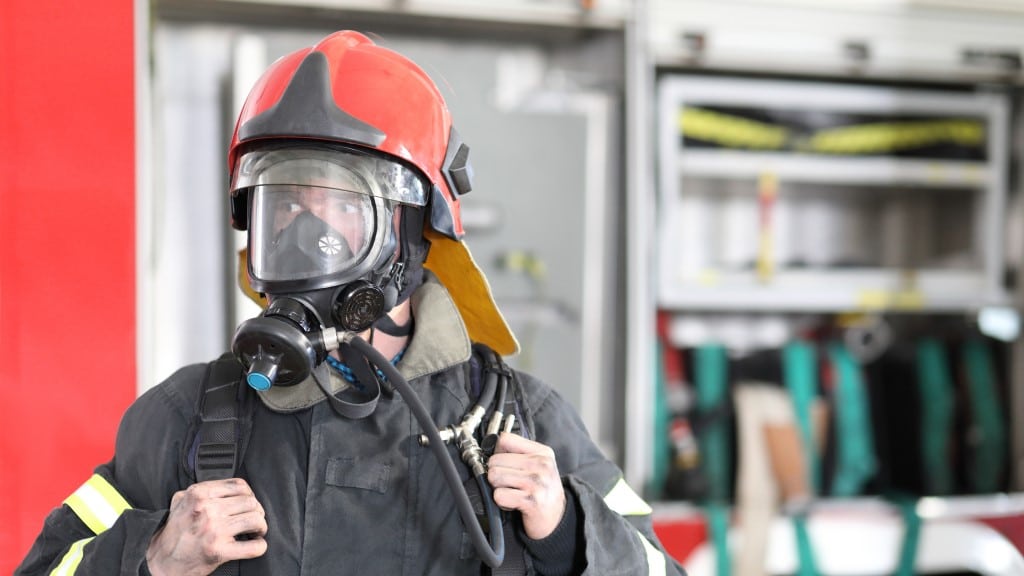Market Analysis: Air compression systems
- October 11, 2023
- 8:00 am


Iain Hoey
Share this content
International Fire and Safety Journal examines the evolving dynamics of the air compression systems market
The global air compressor market, foundational to numerous industrial applications including fire and rescue, symbolises the technological prowess and commitment of businesses to efficiency and sustainability.
These sophisticated machines, beyond their primary role, echo an era where energy efficiency and environmental consciousness have become paramount.
The global air compressor market was valued at USD 33,625.7 million in 2022, according to Grand View Research.
It is projected to grow at a compound annual growth rate (CAGR) of 3.4% between 2023 and 2030.
The COVID-19 pandemic, and the subsequent lockdowns in 2020, negatively impacted several sectors, including the air compressor market.
This led to a decline in sales and profits.
The second wave of the virus and its resulting lockdowns further curtailed investments, especially in the oil and gas sector, which in turn influenced the market’s growth trajectory.
Post-pandemic, there has been a noticeable shift towards emphasising energy efficiency, energy recovery, and reduction in CO2 emissions.
This is expected to increase the demand for air compressors.
Other factors contributing to the projected growth include a rise in demand from the food & beverage sector, propelled by stringent health and safety regulations, and increased investments in oil & gas extraction activities, particularly in North America and the Middle East.
The market has also witnessed a growing demand for variable-speed systems and energy-efficient compressors, both known for their cost-effective operations.
However, there are concerns regarding air quality due to the increasing number of gas compressor stations, prompting a push for air monitoring systems.
Major companies, such as Ingersoll Rand Plc and Atlas Copco Inc., have been at the forefront, introducing eco-friendly and low-maintenance systems.
Type insights
In 2022, stationary air compressors held over 50% of the market share, largely due to their widespread use in manufacturing and the oil and gas sectors.
Portable air compressors, on the other hand, are predicted to experience higher growth over the forecast period.
This is attributed to their increasing use in construction and mining activities, coupled with their reliability and lower maintenance needs.
Segmentation of the air compressor market, based on product, encompasses rotary/screw, reciprocating/piston, and centrifugal compressors.
Predominantly, the rotary segment is expected to lead in market share throughout the forecast period.
A significant factor contributing to this dominance is the prevalent adoption of rotary air compressors across extensive industrial applications.
Noteworthy sectors include papermaking, printing, metallurgy, mining, electronic, electrical, as well as mechanical and electrical machinery.
Meanwhile, the centrifugal segment is projected to experience the highest growth rate (CAGR) during the forecast window.
Advantages such as energy efficiency, fewer rubbing parts, and higher airflow compared to other compressors amplify its demand.
Primary applications for these compressors include gas turbines, oil refineries, petro-manufacturing, food and beverage, and manufacturing plants.
Applications
With regard to application, the market divides into sectors such as manufacturing, semiconductors and electronics, food and beverage, home appliances, healthcare/medical, oil and gas, and energy.
Other applications include construction and metal and mining.
In 2022, manufacturing emerged as the dominant sector, propelled by rapid industrialisation in burgeoning economies like India, China, and Brazil.
Moreover, a rising demand for advanced and energy-efficient air compressors in manufacturing underpins this dominance.
Interestingly, the oil and gas sector is projected to experience the most significant growth rate over the forecasted period.
This can be traced back to the escalating demand for air compressors in reservoir pressure preservation re-injection.
Regulations, such as the Russian mandate requiring 95% of associated petroleum gas to undergo compression for crude oil’s initial treatment pre-pipeline transportation, further reinforce this trend.
Regional breakdown
In 2022, the Asia Pacific region constituted over 30% of the market share, underlined by continual governmental investment in infrastructure and rapid industrialisation.
The growth stems from demand across applications, notably food and beverage, manufacturing, home appliances, and oil and gas.
The concentration of compressor manufacturers in India and China, coupled with the expansive industrial base for electronics and semiconductor manufacturing in regions like China and Taiwan, bolsters the market’s trajectory.
Conversely, North America and Europe are projected to experience steady growth during the forecast period.
The potential growth in Eastern Europe, spurred by heightened investments, may pave the way for more industrial air compressor opportunities.
A rising consumer emphasis on user-friendly, energy-efficient products further augments the market’s growth potential in these regions.
SCBA
Breathing apparatus devices, especially within the realm of fire and safety applications, have always been closely linked to air compression systems.
These intricate devices, which offer respiratory protection against toxic environments and smog-filled scenarios, fundamentally rely on compressed air to function.
At the core of these apparatuses is a system that regulates and delivers breathable air under pressure.
As the demand for enhanced safety equipment soars, so does the demand for advanced air compression mechanisms.
These compressors not only store and release air to the apparatus but ensure it’s free from contaminants, properly humidified, and at the right pressure.
The partnership between breathing apparatus and air compression systems is symbiotic – the evolution and enhancement of one invariably impacts the other.
As industries and regulatory bodies further invest in human safety, the symbiosis of these two components becomes more critical, ensuring that as fire-related challenges grow in complexity, the response mechanisms evolve in tandem.

